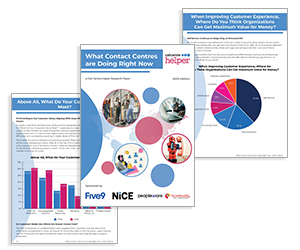Nathan Stearns at NiCE breaks down what contact centres need to know about the rise of AI-powered self-service and how workforce management can adapt in a bot-infused world.
Customer self-service has been a go-to solution for easing the load in contact centres for a long time. Think about IVRs – they’ve been around since the 1970s, helping automate basic tasks.
Over the years, better search engines have made it easier for customers to find answers themselves by tapping into knowledge bases.
Tools like these have been working side by side with contact centre teams for decades, giving agents some breathing room and helping reduce the constant need for businesses to grow their headcount.
Lately, chatbots and generative AI have seriously levelled up the self-service game. During the pandemic, digital channels exploded – and so did the use of bots in contact centres.
Before that, customers were only using chat and AI bots around 10% of the time. But things have changed fast. According to Gartner, chatbots are on track to become the main way customers connect with companies by 2027.
Even more interesting? They predict that around 40% of customer interactions will be handled by unofficial bots – like ChatGPT or Apple Intelligence.
Turns out, customers are really on board with this shift, too. A survey from Heretto found that most people actually prefer starting with self-service when they need help.
And AI chatbots aren’t just convenient – they’re getting results. A Glassix study shows they resolve issues 71% of the time and even do it 18% faster than human agents.
contact centre agents are starting to see the real perks of having AI on their side. These days, chatbots are handling about 30% of the tasks agents used to do themselves.
That frees them up to focus on the conversations that really need a human touch. It’s not just about lightening the load -it’s a big win for efficiency.
A survey by LangChain found that agents using AI tools like chatbots aren’t just getting help with the repetitive stuff – they’re able to spend more time on the meaningful, complex interactions that truly make a difference.
And today’s AI chatbots are smarter than ever. Thanks to generative AI, they can hold more natural, context-aware conversations. Unlike the old-school bots that just followed a script, these new ones pick up on context and nuance, so their responses feel more helpful – and a lot more human.
In 2025, contact centres are leaning into AI to work smarter, not harder. It’s helping teams run more efficiently, personalize customer experiences, and simplify the way things get done.
5 Top Trends in 2025
Here are some of the top trends making that happen:
1. Agentic AI – From Copilot to Autopilot
AI isn’t just backing up agents anymore – it’s starting to take the lead on more complex tasks. These new “agentic” systems don’t just assist; they can actually analyse data, make decisions, and take action on their own, with minimal human involvement. The result? Big boosts in efficiency and some serious cost savings.
2. Empathetic AI Enhancing Customer Interactions
AI tools are getting better at picking up on human emotions in real time, which means they can respond in a more personal and empathetic way.
That kind of connection goes a long way – it helps build stronger relationships with customers and leaves them feeling more satisfied with the experience.
3. Enhanced Multimodal Support
AI makes it easier for contact centres to support customers on whatever channel they prefer – voice, text, or visual interactions. It’s all about creating a smooth, connected experience so customers can get help in the best format for them.
4. Advanced Chatbots and Virtual Assistants
More companies are now using advanced chatbots that can handle even the tricky, complex interactions, and it’s really paying off. Customers stay more engaged, and things run more smoothly behind the scenes.
5. Ethical AI and Data Privacy
As AI becomes more common, there’s a bigger focus on doing it right – making sure these systems are transparent, responsible, and follow the rules regarding data privacy. It’s all about building trust while keeping everything ethical and above board.
As more contact centres start reaping the benefits of bots, it’s raising some big questions about where workforce management (WFM) fits into all of this. If you’re navigating a bot-infused world, here are a few things to keep in mind.
WFM Forecasting
Most WFM systems are designed with people in mind – they focus strictly on managing the human side of the workforce.
So even if you’re among the 58% of contact centres that have integrated your chatbot with your WFM tools, most of what gets tracked is the agents’ workload and interaction history – not what the bots or IVRs handle.
That means when your WFM system forecasts staffing needs, it filters out self-service interactions and zeroes in on what your agents actually handled.
And here’s the cool part: if your self-service channels get better and start resolving more on their own, the system automatically adjusts and shows a lighter agent workload – and the opposite happens if self-service dips.
You don’t need to tweak anything manually. Your WFM tools adapt on their own, giving you smart, reliable staffing forecasts either way.
WFM Scheduling Practices
How well your bots perform doesn’t directly change how you schedule your team. Instead, their impact shows up naturally over time.
As more customers use self-service, your agents handle fewer interactions – and that shift gets reflected in the historical data your WFM system uses to forecast and schedule.
It’s kind of like IVRs – you wouldn’t build your staffing plan around how well your IVR is working, right? Same goes for bots. There’s no need for a WFM system to plan employee schedules around bot success rates.
What really matters is the data your WFM system collects about your human workforce. That’s what it uses to make smart, accurate scheduling decisions.
WFM Change Management
WFM forecasting algorithms should be designed to adjust automatically and respond to shifts in self-service performance.
This kind of smart forecasting has been around since the rise of IVRs back in the 1980s. When success rates for bots, IVRs, or other self-service tools suddenly change, the algorithms automatically clean up the data – removing any outliers – so your forecasts stay accurate. They’re tuned in to the ups and downs of what self-service is (or isn’t) handling.
On top of that, a good WFM system shouldn’t forecast for the whole day – it should break it down by interval. That’s a big deal because it helps contact centres react quickly to sudden changes in bot or IVR performance that might only show up at certain times of day.
With a solution, intraday reforecasting happens automatically, adjusting staffing needs in near real-time based on how your self-service tools are performing.
This blog post has been re-published by kind permission of NiCE-ltd – View the Original Article
For more information about NiCE-ltd - visit the NiCE-ltd Website
Call Centre Helper is not responsible for the content of these guest blog posts. The opinions expressed in this article are those of the author, and do not necessarily reflect those of Call Centre Helper.
Author: NiCE-ltd
Reviewed by: Jo Robinson
Published On: 18th Sep 2025
Read more about - Guest Blogs, NiCE, NiCE CXone






 NiCE (NASDAQ: NICE) is transforming the world with AI that puts people first. Our purpose-built AI-powered platforms automate engagements into proactive, safe, intelligent actions, empowering individuals and organizations to innovate and act, from interaction to resolution. Trusted by organizations throughout 150+ countries worldwide, NiCE’s platforms are widely adopted across industries connecting people, systems, and workflows to work smarter at scale, elevating performance across the organization, delivering proven measurable outcomes.
NiCE (NASDAQ: NICE) is transforming the world with AI that puts people first. Our purpose-built AI-powered platforms automate engagements into proactive, safe, intelligent actions, empowering individuals and organizations to innovate and act, from interaction to resolution. Trusted by organizations throughout 150+ countries worldwide, NiCE’s platforms are widely adopted across industries connecting people, systems, and workflows to work smarter at scale, elevating performance across the organization, delivering proven measurable outcomes. 































